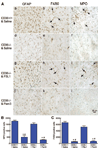Key role of CD36 in Toll-like receptor 2 signaling in cerebral ischemia
- PMID: 20360550
- PMCID: PMC2950279
- DOI: 10.1161/STROKEAHA.109.572552
Key role of CD36 in Toll-like receptor 2 signaling in cerebral ischemia
Abstract
Background and purpose: Toll-like receptors (TLRs) and the scavenger receptor CD36 are key molecular sensors for the innate immune response to invading pathogens. However, these receptors may also recognize endogenous "danger signals" generated during brain injury, such as cerebral ischemia, and trigger a maladaptive inflammatory reaction. Indeed, CD36 and TLR2 and 4 are involved in the inflammation and related tissue damage caused by brain ischemia. Because CD36 may act as a coreceptor for TLR2 heterodimers (TLR2/1 or TLR2/6), we tested whether such interaction plays a role in ischemic brain injury.
Methods: The TLR activators FSL-1 (TLR2/6), Pam3 (TLR2/1), or lipopolysaccharide (TLR4) were injected intracerebroventricularly into wild-type or CD36-null mice, and inflammatory gene expression was assessed in the brain. The effect of TLR activators on the infarct produced by transient middle cerebral artery occlusion was also studied.
Results: The inflammatory response induced by TLR2/1 activation, but not TLR2/6 or TLR4 activation, was suppressed in CD36-null mice. Similarly, TLR2/1 activation failed to increase infarct volume in CD36-null mice, whereas TLR2/6 or TLR4 activation exacerbated postischemic inflammation and increased infarct volume. In contrast, the systemic inflammatory response evoked by TLR2/6 activation, but not by TLR2/1 activation, was suppressed in CD36-null mice.
Conclusions: In the brain, TLR2/1 signaling requires CD36. The cooperative signaling of TLR2/1 and CD36 is a critical factor in the inflammatory response and tissue damage evoked by cerebral ischemia. Thus, suppression of CD36-TLR2/1 signaling could be a valuable approach to minimize postischemic inflammation and the attendant brain injury.
Figures





References
-
- Dirnagl U, Iadecola C, Moskowitz MA. Pathobiology of ischaemic stroke: an integrated view. Trends Neurosci. 1999;22:391–397. - PubMed
-
- Rivest S. Regulation of innate immune responses in the brain. Nat Rev Immunol. 2009;9:429–439. - PubMed
-
- Jin MS, Lee JO. Structures of the toll-like receptor family and its ligand complexes. Immunity. 2008;29:182–191. - PubMed
Publication types
MeSH terms
Substances
Grants and funding
LinkOut - more resources
Full Text Sources
Other Literature Sources
Molecular Biology Databases

